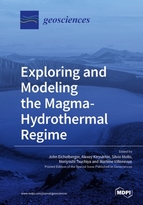Exploring and Modeling the Magma-Hydrothermal Regime
A special issue of Geosciences (ISSN 2076-3263). This special issue belongs to the section "Natural Hazards".
Deadline for manuscript submissions: closed (15 April 2020) | Viewed by 54215
Special Issue Editors
Interests: volcanology; igneous petrology; geothermal energy; scientific drilling; natural hazards; Arctic issues
Interests: geothermal volcanology; hydrogeology
Special Issues, Collections and Topics in MDPI journals
Interests: igneous and experimental petrology
Special Issues, Collections and Topics in MDPI journals
Interests: geology and petrology of supercritical hydrothermal systems
Special Issue Information
Dear Colleagues,
Although associated volcanic and hydrothermal activity are presumed to be the surface expression of “magma–hydrothermal regimes” at depth, the number of papers that actually address the magma–hydrothermal connection is relatively small. Whether as large long-lived magma chambers or frequent small intrusions, nearby magma seems to be required to explain the existence of high-temperature hydrothermal systems. Conversely, because rocks are poor conductors of heat, hydrothermal convection around a magma body is the dominant control of heat loss, thereby influencing evolution and eruption of the magma. Direct interaction of magma and hydrothermal fluid is shown by eruptions that begin with ejection of hydrothermally altered rocks and are later joined by a fresh magmatic component. Whether a phreatic eruption progresses to a more violent magmatic one is a primary concern for volcanologists at observatories. Recently, inadvertent encounters with magma during geothermal drilling show that the magma-hydrothermal connection is closer than many researchers would have expected. We are only beginning to learn from these serendipitous events.
We invite papers that explore the relationship between magma and hydrothermal fluids. Topics will include interpretation of surface-detected geophysical and geochemical signals from active magma–hydrothermal regimes, modeling that treats coupling between magma and hydrothermal systems in terms of heat and mass transport, geologic evidence (“fossil systems”) of hydrothermal–magma relationships, and direct observations of the magma or near-magma environment through drilling. The goal of this Special Issue is to assemble as broad a view as possible about the dynamics of the magma–hydrothermal regime and thus accelerate research that is relevant to both volcanic hazards and geothermal energy.
Prof. John C. Eichelberger
Dr. Alexey Kiryukhin
Prof. Silvio Mollo
Prof. Noriyoshi Tsuchiya
Dr. Marlène Villeneuve
Guest Editors
Manuscript Submission Information
Manuscripts should be submitted online at www.mdpi.com by registering and logging in to this website. Once you are registered, click here to go to the submission form. Manuscripts can be submitted until the deadline. All submissions that pass pre-check are peer-reviewed. Accepted papers will be published continuously in the journal (as soon as accepted) and will be listed together on the special issue website. Research articles, review articles as well as short communications are invited. For planned papers, a title and short abstract (about 100 words) can be sent to the Editorial Office for announcement on this website.
Submitted manuscripts should not have been published previously, nor be under consideration for publication elsewhere (except conference proceedings papers). All manuscripts are thoroughly refereed through a single-blind peer-review process. A guide for authors and other relevant information for submission of manuscripts is available on the Instructions for Authors page. Geosciences is an international peer-reviewed open access monthly journal published by MDPI.
Please visit the Instructions for Authors page before submitting a manuscript. The Article Processing Charge (APC) for publication in this open access journal is 1800 CHF (Swiss Francs). Submitted papers should be well formatted and use good English. Authors may use MDPI's English editing service prior to publication or during author revisions.
Keywords
- Magma–hydrothermal
- Geothermal energy
- Volcanology
- Hydrothermal convection
- Magma convection
- Heat transport
- Gas and fluid geochemistry
- Phreatomagmatic eruption
- Volcano monitoring
- Geophysical imaging







